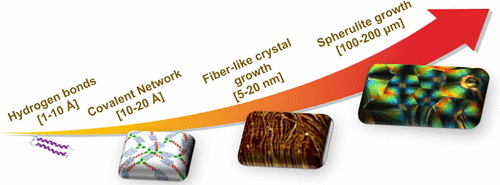当前位置:
X-MOL 学术
›
Biomacromolecules
›
论文详情
Our official English website, www.x-mol.net, welcomes your feedback! (Note: you will need to create a separate account there.)
Secondary-Structure-Mediated Hierarchy and Mechanics in Polyurea–Peptide Hybrids
Biomacromolecules ( IF 6.2 ) Pub Date : 2018-07-12 00:00:00 , DOI: 10.1021/acs.biomac.8b00762 Lindsay E. Matolyak 1 , Chase B. Thompson 2 , Bingrui Li 1 , Jong K. Keum 3 , Jonathan E. Cowen 4 , Richard S. Tomazin 4 , LaShanda T. J. Korley 2, 5
Biomacromolecules ( IF 6.2 ) Pub Date : 2018-07-12 00:00:00 , DOI: 10.1021/acs.biomac.8b00762 Lindsay E. Matolyak 1 , Chase B. Thompson 2 , Bingrui Li 1 , Jong K. Keum 3 , Jonathan E. Cowen 4 , Richard S. Tomazin 4 , LaShanda T. J. Korley 2, 5
Affiliation

|
Peptide–polymer hybrids combine the hierarchy of biological species with synthetic concepts to achieve control over molecular design and material properties. By further incorporating covalent cross-links, the enhancement of molecular complexity is achieved, allowing for both a physical and covalent network. In this work, the structure and function of poly(ethylene glycol) (PEG)–network hybrids are tuned by varying peptide block length and overall peptide content. Here the impact of poly(ε-carbobenzyloxy-l-lysine) (PZLY) units on block interactions and mechanics is explored by probing secondary structure, PEG crystallinity, and hierarchical organization. The incorporation of PZLY reveals a mixture of α-helices and β-sheets at smaller repeat lengths (n = 5) and selective α-helix formation at a higher peptide molecular weight (n = 20). Secondary structure variations tailored the solid-state film hierarchy, whereby nanoscale fibers and microscale spherulites varied in size depending on the amount of α-helices and β-sheets. This long-range ordering influenced mechanical properties, resulting in a decrease in elongation-at-break (from 400 to 20%) with increasing spherulite diameter. Furthermore, the reduction in soft segment crystallinity with the addition of PZLY resulted in a decrease in moduli. It was determined that, by controlling PZLY content, a balance of physical associations and self-assembly is obtained, leading to tunable PEG crystallinity, spherulite formation, and mechanics.
中文翻译:

二级结构介导的聚脲-肽杂化体的层次结构和力学
肽-聚合物杂化体将生物物种的层次结构与合成概念结合在一起,以实现对分子设计和材料特性的控制。通过进一步掺入共价交联键,可以提高分子的复杂性,从而实现物理和共价网络。在这项工作中,通过改变肽段长度和总肽含量来调节聚乙二醇网络混合物的结构和功能。在这里,聚(ε-羰基苄氧基-1-赖氨酸)(PZLY)单元对嵌段相互作用和力学的影响是通过探查二级结构,PEG结晶度和层次结构来探讨的。PZLY的掺入揭示了在较小的重复长度下,α螺旋和β折叠的混合物(n= 5),并在较高的肽分子量下(n = 20)选择性地形成α-螺旋。二级结构的变化量身定制了固态膜的层次结构,从而纳米级纤维和微米级球晶的尺寸根据α螺旋和β片的数量而变化。这种长程有序影响了机械性能,随着球晶直径的增加,断裂伸长率降低(从400%降至20%)。此外,添加PZLY导致软链段结晶度降低导致模量降低。已确定,通过控制PZLY含量,可以达到物理缔合和自组装的平衡,从而导致可调节的PEG结晶度,球晶形成和力学性能。
更新日期:2018-07-12
中文翻译:

二级结构介导的聚脲-肽杂化体的层次结构和力学
肽-聚合物杂化体将生物物种的层次结构与合成概念结合在一起,以实现对分子设计和材料特性的控制。通过进一步掺入共价交联键,可以提高分子的复杂性,从而实现物理和共价网络。在这项工作中,通过改变肽段长度和总肽含量来调节聚乙二醇网络混合物的结构和功能。在这里,聚(ε-羰基苄氧基-1-赖氨酸)(PZLY)单元对嵌段相互作用和力学的影响是通过探查二级结构,PEG结晶度和层次结构来探讨的。PZLY的掺入揭示了在较小的重复长度下,α螺旋和β折叠的混合物(n= 5),并在较高的肽分子量下(n = 20)选择性地形成α-螺旋。二级结构的变化量身定制了固态膜的层次结构,从而纳米级纤维和微米级球晶的尺寸根据α螺旋和β片的数量而变化。这种长程有序影响了机械性能,随着球晶直径的增加,断裂伸长率降低(从400%降至20%)。此外,添加PZLY导致软链段结晶度降低导致模量降低。已确定,通过控制PZLY含量,可以达到物理缔合和自组装的平衡,从而导致可调节的PEG结晶度,球晶形成和力学性能。


























 京公网安备 11010802027423号
京公网安备 11010802027423号